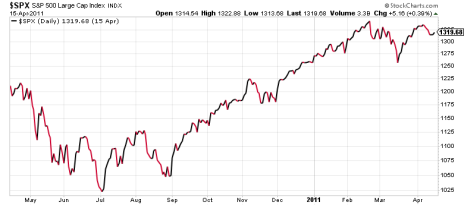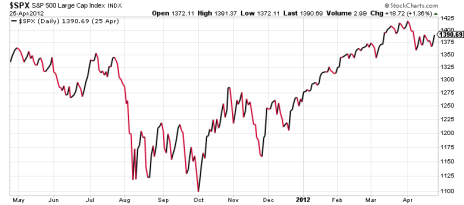Four months ago to the day was one of the bleakest Christmases investors have ever witnessed. Stocks had just had their worst Christmas Eve slide on record, and were down roughly 20% in less than three months. Today, the stock market recovery is complete, and the volatility and uncertainty that hovered over Wall Street at the end of 2018 is gone.
On Tuesday, the S&P 500 and Nasdaq closed at new all-time highs, surpassing their late-summer 2018 peaks. Year to date, the S&P is up nearly 18%, while the Nasdaq has climbed more than 23%.
Where do stocks go from here?
We try not to predict here at Cabot Wealth. The fact that the CBOE Volatility Index (VIX) is at six-month lows bodes well, and things like the Federal Reserve’s decision to put the brakes on interest rates, improving U.S.-China trade relations (for now), and the end of the Mueller investigation have also helped. But none of that guarantees anything.
[text_ad use_post='129622']
To get a true gauge of what to expect from stocks after a full, four-month stock market recovery, the best thing to do is to look at past recoveries. How have stocks behaved in the months following a bounce-back from multi-month lows? Since the 2008-09 recession, I found three such examples of full bounce-backs (prior to 2018) that came on the heels double-digit market corrections.
See if you notice a theme as to what stocks did next in each case:
Stock Market Recovery #1: April 2010-April 2011
From mid-April to early-July 2010, the S&P declined exactly 16%. It didn’t fully recover those losses until November—four months after the July bottom. From there, the index jumped another 9.6% in the next three and a half months, and 11.2% at its April peak.
However, that run-up was promptly followed by another market correction…
Stock Market Recovery #2: April 2011-April 2012
After hitting new all-time highs in April 2011, the S&P started to retreat again, slowly at first before falling like a rock in July and August of that year. From peak to trough, stocks plummeted more than 19%, hitting fresh bottoms at the end of September.
Then the recovery began, and five months later it was complete, with stocks hitting new highs in March 2012. The S&P rallied another 4% before topping out in April. Stocks consolidated from there, dipping as much as 9.2% in late May. But by September they were back at new highs—and continued to climb.
Stock Market Recovery #3: November 2015-August 2016
After three solid years of rallying without much letup, stocks cooled off a bit in late 2015 and early 2016, tumbling more than 11% (and more than 12% from their 2015 peak). The recovery didn’t take long: by late May (roughly three and a half months from the bottom) stocks were back at their pre-correction highs, and by July they were at new all-time highs. They weren’t finished rallying: over the ensuing year, the S&P gained another 13%.
The Takeaway
What can we learn from these three previous recoveries from double-digit corrections? As with the current recovery, the time between rock bottom and pre-correction highs took less than five months. And each time, stocks continued to rise for at least another month without any real interruption.
The 2012 rally fizzled much more quickly than the other two, but the consolidation was short-lived. And the 2011 rally begat another market correction, but not until after stocks gained nearly 10% on top of the recovery.
Let’s hope the just-completed stock market recovery looks more like the 2016 one, where stocks continued to rise for another year with very little pushback. Regardless of which recent recovery the current one looks like, history says that stocks will continue rising, and won’t simply hit their pre-correction peak and then retreat again.
Whether the rally lasts another month or another year is anybody’s guess. But in either case, it’s too early to start your selling stocks.
[author_ad]



